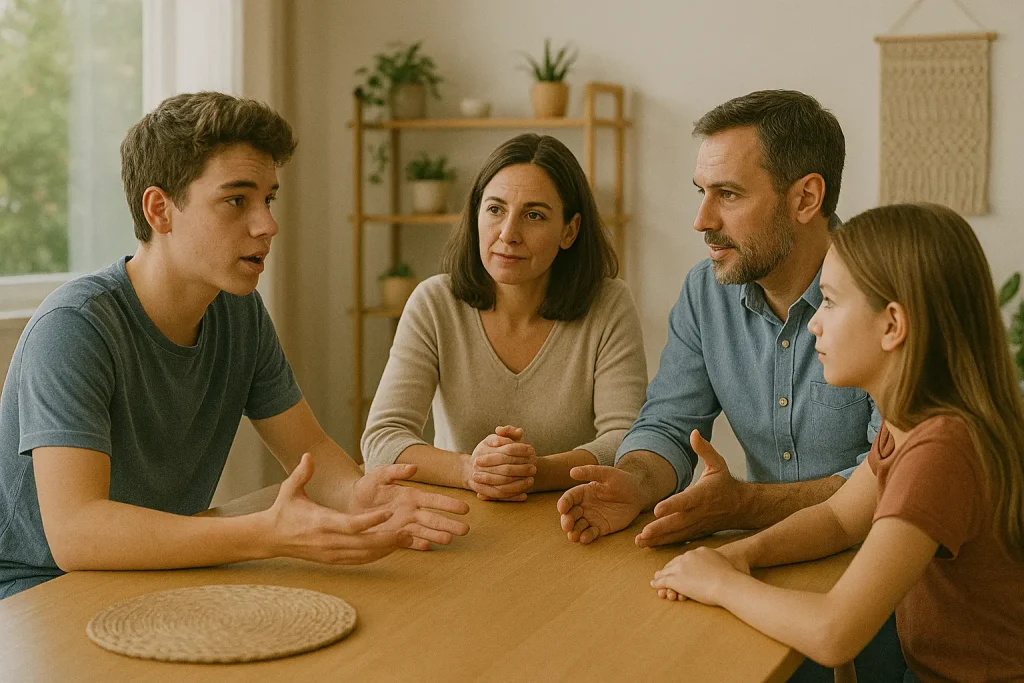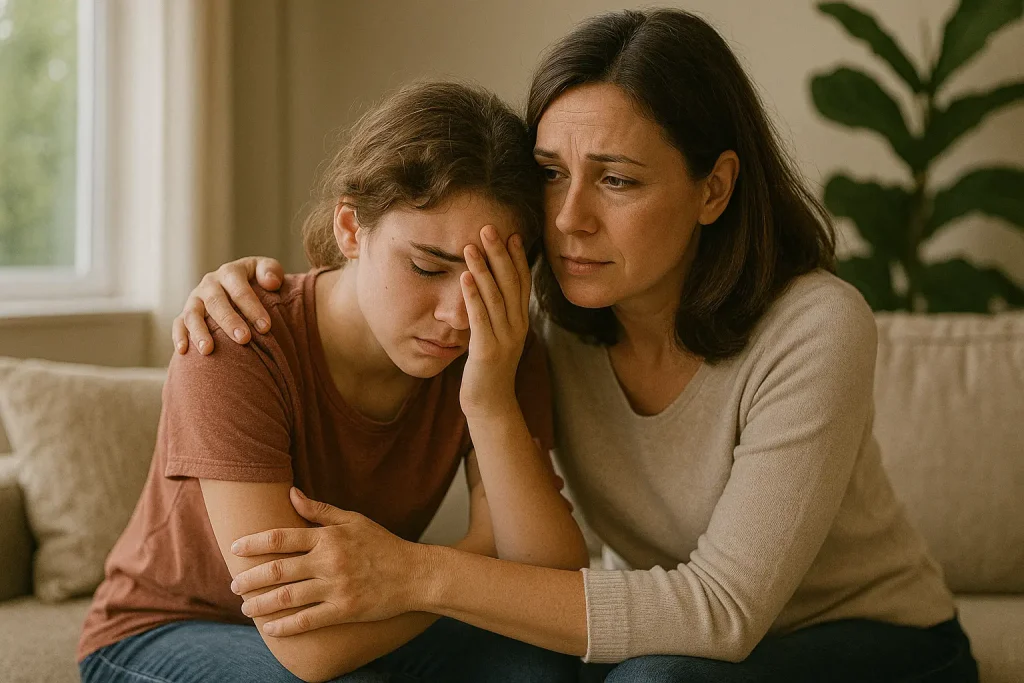As a parenting coach and a mother, I’ve sat with countless families. Each of them navigates the tangled web of screen time, digital distractions, and the fear of losing real connection with their children.
If you’re reading this, you’re probably wrestling with the same question so many of my clients ask:
“How do I set boundaries with technology without creating conflict or guilt?”
I want to tell you this first: you’re not alone. Parenting in the digital age can be really tough. However, This isn’t just a parenting problem. It’s a generational shift. And the good news? It’s one we can navigate together. All we need for this is intention, love, and a whole lot of compassion.
Start with Yourself: Model What You Want to Teach
We can’t ask our children to put away their devices while we’re scrolling at the dinner table. I’ve been there too. In one of my digital detox challenges for parents, the most common feedback wasn’t about less screen time, it was about what families gained back. Eye contact. Slow mornings. Genuine listening.
If we want our children to value human connection, they need to see us living it.
You can start small. Create phone-free zones in your home. For me, the dining table and bedtime are sacred. These tech-free spaces act as grounding rituals where presence is prioritized over pings and notifications.
Create a Family Tech Agreement, Together
In my parenting coaching sessions, I always tell the parents that rules imposed without dialogue often lead to resistance. That’s why I always recommend involving your children in creating a family tech agreement. When we bring them into the process, we build understanding, trust, and mutual respect.
This agreement might include screen-free hours during meals and before bedtime. This could also include approved apps and games, social media boundaries, and what steps to take if they come across something distressing online.
And yes, it’s important for us as parents to follow these rules too. Our actions speak louder than our instructions.

Teach Emotional Regulation, Not Just Screen Limits
What looks like screen addiction is often an emotional coping strategy. Feelings like boredom, loneliness and stress bothers kids. They don’t yet know how to name or navigate, so they reach for the quickest distraction.
That’s why I integrate emotional literacy into all my parenting work. It is incredibly important to help children identify and process their emotions. It is a skill that serves them far beyond any screen limit.
Instead of using devices to soothe a meltdown, try saying, “I see you’re upset. Do you want to talk about it or draw how you feel?” Or, “Would a short walk help your body feel calm?”
When we help our children connect with their inner world, they become less reliant on the outer one for escape.
Design Offline Joy
One of the most powerful antidotes to screen time isn’t restriction, it’s inspiration. If we want our children to unplug, we need to offer a world that’s worth plugging into.
In our home, we have what we call the “Boredom Basket”. We have filled it with puzzles, art supplies, journals, and conversation cards. We have analog days where we bake, build blanket forts, or spend time in nature. These aren’t grand or expensive outings, they’re simple moments of joy and togetherness.
Children are naturally curious and imaginative. They just need the time and space to rediscover it.

Don’t Demonize Tech, Empower Digital Wisdom
We as parents need to understand that technology isn’t inherently harmful, it’s how we engage with it that matters. Watching cartoons for hours is different from exploring a new coding app or editing a short film.
Our role as mindful parents is to guide, not shame. There are different mindful parenting strategies that you can incorporate in your daily life . One of which is that you need to ask open-ended questions that foster digital awareness: “What did you enjoy about that game?” or “Did anything you saw online make you feel confused or unsure?”
These conversations help our children become intentional users of technology, rather than passive consumers.
Ritualize Connection, Every Single Day
In the fast pace of modern life, even five minutes of focused connection can shift the energy of your entire household. It could be a bedtime cuddle, a check-in after school, or a quiet morning coffee before the day begins.
I often ask parents in my sessions, “What’s your child’s favorite way to connect with you?” When we know the answer to that, we hold the key to deeper relationships.
Rituals don’t need to be perfect or long. They just need to be consistent and genuine.
Hold Boundaries with Kindness and Confidence
Yes, you will face pushback. And yes, that’s perfectly normal. Children don’t need to love boundaries, they need to feel safe within them.
When your child says, “But everyone else gets more screen time!” take a breath and remind yourself: you’re not raising someone to fit in. You’re raising someone to stand strong.
Boundaries, when held with kindness, act as safety nets. They are not punishments, they are acts of care. So say it with love. Stand by it with calm. And reinforce it with consistency.

The Real Goal: Connection Over Control
This is the heart of it all. We’re not here to control our children, instead we’re here to connect with them. Apps will change and platforms will evolve, but the depth of your relationship will always matter more than the number of hours spent on a device.
That’s why I do the work I do. To help parents regulate themselves, so they can co-regulate with their children. Because when we lead from within, our children learn to do the same.
When we choose connection, even in the messiness of modern parenting, we build something lasting. Something sacred.
Feeling Overwhelmed? Here’s Where to Begin:
- Choose one screen-free ritual to anchor your day—start with just 10 minutes.
- Reflect on your own digital habits with curiosity, not judgment.
- Invite emotions into the conversation with your child, not just correction.
- And most importantly, give yourself grace. You are doing your best in a world that’s moving fast and asking a lot.

And if you feel like you’re ready to go deeper, I’m here.
Being a parenting coach, through 1:1 coaching and group workshops, I support parents in reclaiming calm, connection, and clarity. You don’t have to navigate this alone. Let’s build a more conscious digital life, for you and your children.
With love,
Nermine
Frequently Asked Questions
What are effective screen-free activities for kids?
The key is to make the offline world more engaging. You could keep a “boredom basket” with books, puzzles, and art supplies. You should create simple rituals like family walks, cooking together, or evening games. Children naturally gravitate toward creativity when they have space and encouragement to explore it.
How can I limit screen time for kids?
You need to start by setting age-appropriate limits. For example, you could go for one hour per day for young kids. You could also use tools like Apple’s Screen Time or Google Family Link to monitor usage. Even small steps like halving current screen time and introducing tech-free zones can create real change.
How does screen time affect my child’s health?
Screen time and child development are greatly inter-linked. It is important to note that too much screen time can disrupt sleep, increase anxiety, affect posture, and limit real-world social skills. On the flip side, mindful screen use, like learning apps or family video calls can be supportive. The focus should be on quality, not just quantity.
How do I manage screen transitions without meltdowns?
Avoid abrupt shutdowns by giving countdowns. You could be using visible timers, and helping kids finish their current activity. Let them know what’s coming next.
Are all screen activities equally bad?
Not at all. Passive scrolling isn’t the same as active learning or creating. Encourage educational apps, coding games, music-making, or family FaceTime chats. The goal is a balanced digital diet—not a total screen ban.




